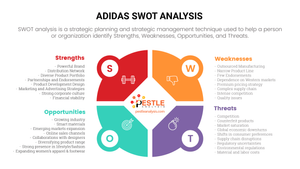This SWOT analysis of Adidas is picking apart the Strengths, Weaknesses, Opportunities, and Threats affecting the sportswear company.
Did you know that the name "Adidas" is derived from the founder, Adolf "Adi" Dassler's, nickname (Adi) and the first three letters of his surname (Das)? Now that you know what Adidas means, as this debunks the popular but incorrect belief that it stands for "All Day I Dream About Sports" we're set to begin our SWOT analysis of Adidas.
Today's SWOT will complement our PESTLE analysis of Adidas we conducted here at PESTLEanalysis. By picking apart Adidas' Strengths, Weaknesses, Opportunities, and Threats, you'll be amazed to see their potential for both extreme upside and downside!
With that in mind, today's Adidas SWOT analysis will:
- Begin by highlighting the strengths that cement Adidas's position in the global sportswear industry,
- Proceed to the weaknesses that Adidas must navigate to maintain its competitive edge,
- Explore the opportunities that Adidas can leverage in the expanding sports and lifestyle market, and
- Uncover the threats facing Adidas in one of the most dynamic and competitive sectors.
Through this analysis, we will delve into what is achievable in the realms of sportswear and fashion. In the meantime, I’ve written everything you need to know about SWOT here.
Adidas Strengths
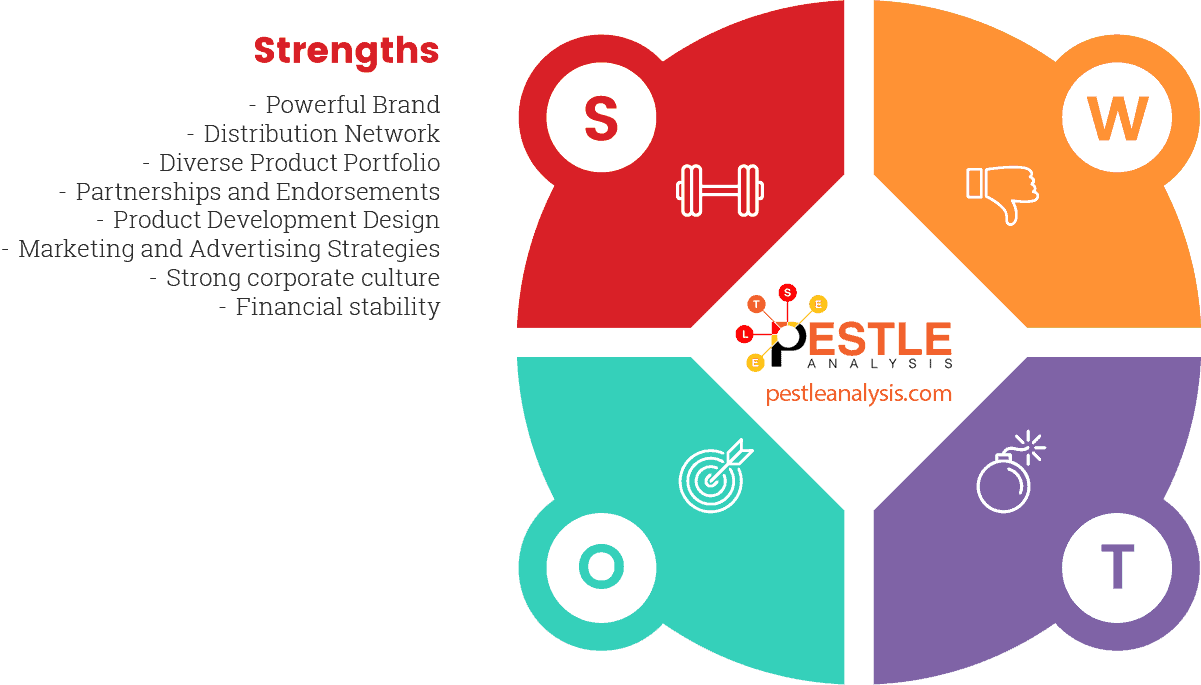
Did you know that Adidas has a historical rivalry with Puma, which was actually founded by Adolf Dassler's brother, Rudolf Dassler?
Now you know, as we begin our SWOT Analysis of Adidas by finding out the brand's strengths.
Powerful Brand
One of Adidas' biggest strengths is, without a doubt, its powerful brand.
Alongside Nike and several others, Adidas is one of the premium sportswear brands recognized in every corner of the globe. Not only does the brand have widespread awareness, but it's also a positive brand image. Adidas products are associated with being fashionable and relatively high quality.
All in all, Adidas' powerful brand is a key part of how it manages to capture such a large fraction of the luxury sportswear sales.
Distribution Network
Aside from its excellent brand image, Adidas also has a well-developed distribution network. On a logistical level, the Adidas distribution network ships millions of goods across the globe in reasonable timeframes.
When products are ready for retail, customers have plenty of choices in how and where they can purchase. Adidas sells its products in brick and mortar stores across the world — some of them Adidas-branded stores and others larger-scale sportswear retailers. Aside from physical sales, Adidas also has an established eCommerce presence.
Products are available to purchase in thousands of internet stores, including Amazon and Adidas' own stores.
More Adidas Strengths
- Diverse and innovative product portfolio: Because Adidas isn't known for just a single shoe design.
- Strategic partnerships and endorsements with celebrities and athletes make the Adidas brand logo appear very often in front of consumers' eyes.
- Advanced technology and design in product development is keeping Adidas at the top of the industry.
- Strong presence in both sports and fashion industries doesn't leave much room to competition.
- Effective marketing and advertising strategies guarantee Adidas' revenues.
- Sustainability initiatives and commitment to environmental responsibility make people prefer Adidas' products.
- Experienced management and strong corporate culture create a working environment that everyone envies.
- Financial stability and robust revenue growth allows for stress-free conditions.
Adidas Weaknesses
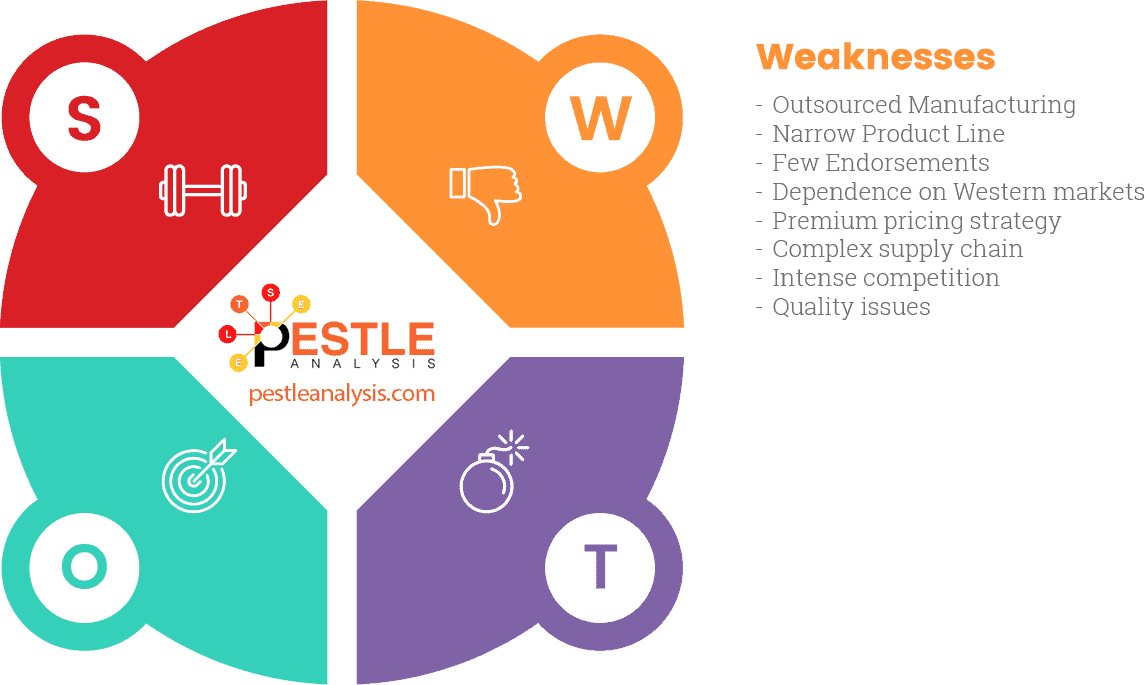
Did you know that at the 1936 Berlin Olympics, Adi Dassler managed to persuade American sprinter Jesse Owens to wear his shoes?
Now you know, as we continue our SWOT Analysis of Adidas by investigating the brand's weaknesses.
Outsourced Manufacturing
Adidas outsources the production of its products to Far Eastern manufacturers. While this strategy does allow the brand to cut costs, it's one of their major weaknesses.
By outsourcing manufacturing processes to third-party suppliers working overseas, Adidas loses some control over how its products are made. This makes it extremely difficult for Adidas to ensure all of its products meet the same rigorous quality standards.
Furthermore, by outsourcing the manufacture of its products, Adidas is put at the mercy of third-party suppliers. If the suppliers are, for example, unhappy with compensation, they can simply stop working. This can quickly cause issues for a company as big as Adidas.
Narrow Product Line
Another major weakness facing Adidas is its narrow product line.
Despite diversification across multiple price ranges and international markets, Adidas has not yet opted to diversify its product line. Currently, Adidas almost exclusively offers sportswear products, with a focus on footwear. It's hard to imagine the sportswear industry getting any smaller, but it's not hard to imagine new competitors forcing their way into the market and siphoning away Adidas' market share.
If Adidas were more diversified in the products it offers, it would be less shaken by market changes or new competitors.
Few Endorsements
Unlike Nike, Adidas has invested very little in securing celebrity endorsements for its products.
This is objectively a weakness, since it has led to Adidas constantly lagging behind Nike in terms of growth. While the Adidas brand is strong enough as it is now, there's no doubt that paid endorsements could only improve it.
It's also worth noting that endorsements not only increase brand value, but they also drive sales directly.
More Adidas Weaknesses
- High dependence on Western markets may turn against Adidas at some point.
- Premium pricing strategy makes Adidas products not affordable for many.
- Complex supply chain is destined to cause problems.
- Intense competition doesn't make Adidas' life easier!
- Product recalls and quality issues causes damage to trust and reputation.
- Vulnerability to currency fluctuations, which is a common issue for companies operating worldwide.
Adidas Opportunities
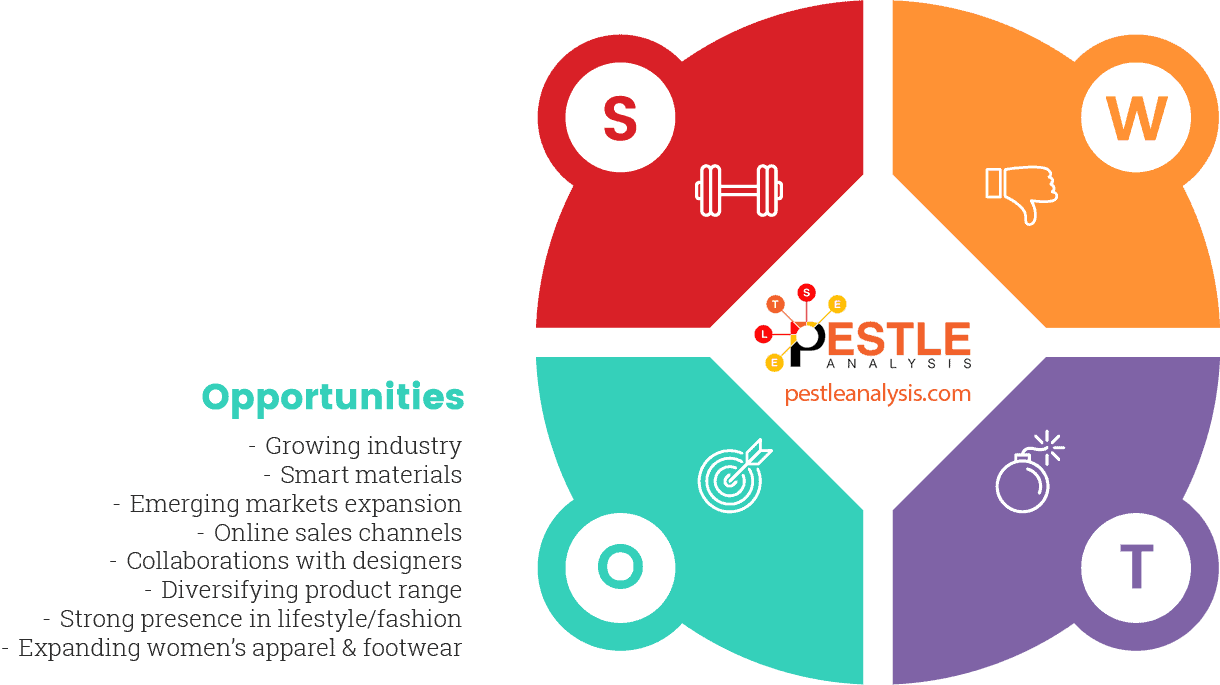
Did you know that Adidas has a long-standing relationship with the FIFA World Cup, providing the official ball for every World Cup since 1970?
Now you know, as we explore the brand's opportunities in our SWOT Analysis of Adidas.
Growing Industry
The primary opportunity for Adidas may well be the growing sportswear industry.
Health and fitness are hotter than ever, and there's no sign they'll be slowing down any time soon. This means there will be a consistent increase in the number of people practicing sport and thus needing appropriate sportswear. This is not an opportunity unique to Adidas, however.
Other sportswear brands will be exposed to the same, growing industry, and it's up to Adidas to think of clever ways to outpace them.
Smart Materials
Science is more advanced than ever. Every week, new materials are discovered that have dozens of benefits over traditional alternatives. To add to that, consumers are always looking for products that are built better.
These two factors together present a new opportunity for Adidas: the use of smart materials. By continually investing in the development and manufacture of new materials that can be used in sportswear, Adidas may be able to offer a superior product to its competitors.
For example, Adidas could invest in developing new, breathable fabrics to keep sportspeople extra-cool in the summer, or various gums and rubbers to improve the reaction of running shoes with each step.
More Adidas Opportunities
- Expanding into emerging markets: Entering a new market is always an opportunity for more revenue.
- Increasing online sales channels: People are more familiar with online shopping than ever before.
- Growing demand for sustainable products: Consumers will prefer products that last longer than their competitors.
- Collaborations with celebrities and designers: Adidas can always hire influencers to reach new audiences.
- Diversifying product range: While shoes and clothing are fine, Adidas can branch out to other types of products.
- Leveraging advanced technology for innovation: Perhaps Artificial Intelligence can make it into the sportswear industry somehow?
- Strengthening presence in lifestyle and fashion segments: This will stop associating the Adidas brand with sports.
- Capitalizing on health and fitness trends as people are becoming more health-aware.
- Expanding women’s sports apparel and footwear as they are the driving force when it comes to the clothing industry.
Adidas Threats
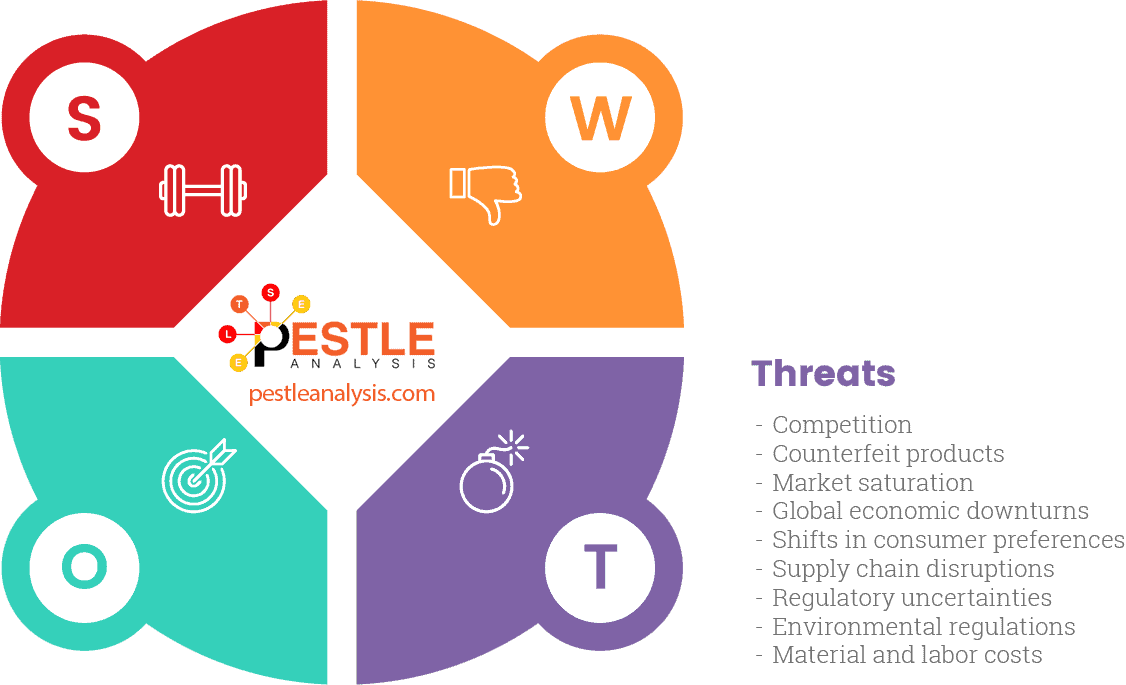
Did you know that Adidas once released the "Adidas 1," the first-ever microprocessor-controlled smart shoe, capable of automatically adjusting its cushioning level to the wearer's environment?
Now you know, as we're finalizing our SWOT Analysis of Adidas by exploring its threats.
Competition
As with any company, the threat of competition is always present. Adidas is known for its fierce rivalry with Nike, and they really can't drop their guard in that battle.
As it stands, consumers choose between Adidas and Nike on the basis of personal preference, since there's no major difference in the product lines or qualities. This is why it's incredibly important that Adidas continues to promote its brand image, hence the suggestion of celebrity endorsements discussed previously.
Counterfeit Products
The sportswear industry is ripe with counterfeit products.
Given the hefty price tags of premium sports apparel brands such as Nike and Adidas, it should come as no surprise that many consumers want a cheaper alternative, but with the same powerful brand.
Counterfeit products already exist for Adidas, but the company has done a good job of encouraging consumers to buy the real thing. However, if Adidas were to have a fallout with one of its overseas suppliers, the risk of a huge influx of counterfeit products is an extremely scary prospect.
More Adidas Threats
- Market saturation in key segments: Too many products, too few consumers.
- Global economic downturns: The economy isn't always at its best.
- Shifts in consumer preferences: The orange will not always be the new black.
- Supply chain disruptions will always play a significant role in the operation of every global brand.
- Regulatory and political uncertainties as the world is shaken by unforeseen events.
- Rising material and labor costs as inflation affects everything and everyone.
- Environmental regulations since people and governments favor a greener future.
- Technological advancements by competitors: Adidas doesn't want to be left behind.
As you've seen, Adidas is an extremely strong brand in the world of sporting goods.
This powerful branding alongside with its brilliant distribution infrastructure is balanced only by a few small weaknesses — namely outsourced manufacturing, a narrow product line, and limited celebrity endorsements.
However, Adidas does have opportunities for the future in this growing industry — such as smart materials — if it can only survive the competition! The question is, can Adidas handle the heat?
Recommendations based on the SWOT Analysis of Adidas
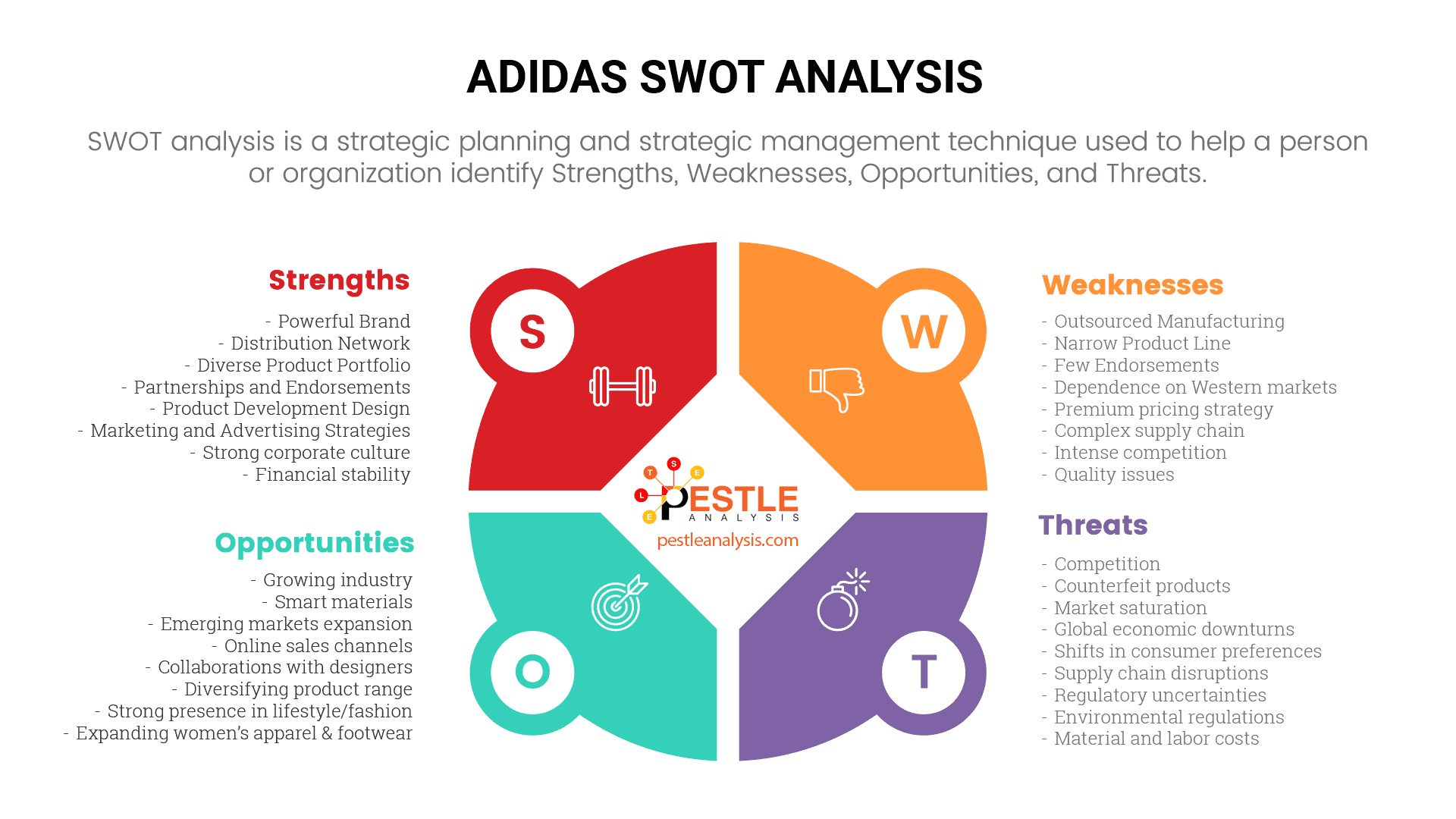
Based on out most recent SWOT analysis of Adidas, several strategic recommendations emerge for the company to enhance its competitive positioning:
- Innovation and R&D Investment: Continue investment in R&D to foster innovation and maintain competitive edge.
- Sustainability Efforts: Enhance sustainability efforts to align with environmental consciousness and reduce waste.
- E-commerce Enhancement: Improve e-commerce capabilities to offer a seamless shopping experience and grow the customer base.
- Expanding Partnerships: Expand partnerships with famous athletes and celebrities to boost brand recognition.
- Focus on Digital Operations: Leverage online sales channels and partnerships with e-commerce platforms for market capture.
- Equipment Diversification: Diversify product lines into sporting equipment to differentiate from competitors.
- Market Expansion: Pursue market expansion, especially in Asia and Eastern Europe, to capture new segments.
- Tech and Smart Materials: Explore new materials and technologies for product innovation and improved performance.
Wrapping up our SWOT Analysis of Adidas, it's quite possible I've missed a few things. If you believe we've missed a critical aspect of Adidas' SWOT, or if you have insights that could enrich the discussion, I invite you to share your remarks with us.
In the meantime, you may check out analysis we've conducted before on Adidas' main competitors. This will help you understand better Adidas' market:
- SWOT Analysis of PUMA
- SWOT Analysis of Under Armour
- SWOT Analysis of Nike

